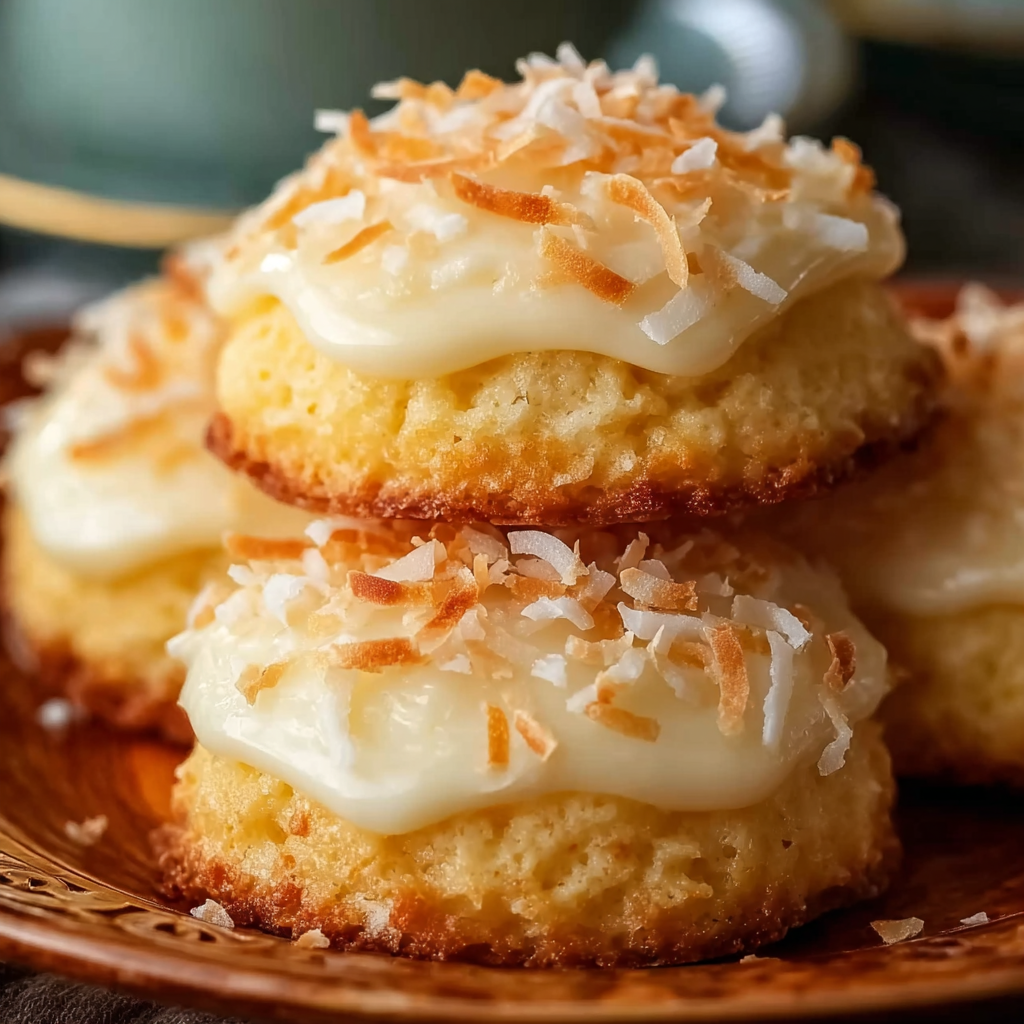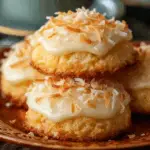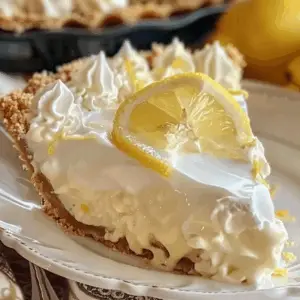Quick Coconut Biscuits (Buttery Milk Biscuits) — Easy Pantry Recipe
Introduction & Promise
There’s something comforting about a batch of freshly baked coconut biscuits—the crisp edges, the buttery crumb, and that warm, fragrant coconut aroma wafting through the kitchen. This recipe delivers all of that in less than half an hour, using simple pantry staples you probably already have. Whether you’re baking for a tea break, a quick dessert, or an edible gift, these buttery milk biscuits are as effortless as they are delicious.
Unlike traditional coconut macaroons, which are mostly egg and sugar, these biscuits have a tender, shortbread-like texture thanks to the combination of unsalted butter, sweetened condensed milk, and milk powder. If you’ve ever wondered about the difference between biscuits and cookies, this Wikipedia article on biscuits explains the regional terminology and history, while our own homemade shortbread guide offers tips for achieving the perfect crumb.
Another secret to their success lies in the unsweetened desiccated coconut. Not only does it boost flavor, but it also adds a delicate chew to every bite. You can learn more about the processing and uses of this ingredient in this Wikipedia overview of desiccated coconut. For extra baking science insight, check out the section on butter composition in baking, which explains why room-temperature butter is key to the perfect spread and texture.
The best part? These coconut biscuits can be made last minute—no chilling, no fancy tools, and no complicated steps. Just mix, roll, and bake. In the sections ahead, we’ll cover everything from ingredient swaps to storage tips so you can master the art of the quick coconut biscuit.

Why You’ll Love This Recipe
If you enjoy baking without the fuss, this quick coconut biscuit recipe will become a staple in your kitchen. It’s perfect for busy days when you want something homemade but don’t have hours to spare. With a bake time of just over 10 minutes, you can have a plate of golden, buttery biscuits ready before your coffee finishes brewing.
One of the biggest draws is how approachable it is. There’s no complex technique—just simple mixing and baking. Whether you’re a beginner or a seasoned baker, you’ll appreciate how this recipe uses common pantry ingredients like all-purpose flour (learn more in this Wikipedia flour guide) and baking powder (how it works here) to create consistent results. If you’ve browsed our easy cookie recipes collection before, you’ll notice this one stands out for its short ingredient list and reliability.
It’s also an egg-free recipe, making it friendly for households with allergies. Plus, the combination of milk powder and sweetened condensed milk (condensed milk explained) delivers a rich flavor that feels indulgent without requiring special ingredients. If you’re curious about how milk powder enhances baked goods, check out this detailed Wikipedia article on dry milk. This clever pairing is what gives the biscuits their creamy undertone and tender bite.
These are the kind of biscuits that disappear quickly—whether served alongside tea, packed into lunchboxes, or wrapped as gifts. And once you see how quick and versatile they are, you might find yourself making double batches.
Recipe at a Glance
This quick coconut biscuit recipe is designed for speed, simplicity, and flavor. You’ll get small, buttery milk biscuits with crisp edges and a soft, short interior—perfect for tea breaks or last-minute treats.
It yields about 24 to 28 biscuits when scooped with a 1-tablespoon measure, making it ideal for small gatherings or easy storage. Total prep time is around 10 minutes, with just 10–12 minutes of baking. That means you can go from mixing bowl to cooling rack in under half an hour.
Best of all, the ingredient list is short and forgiving. With unsweetened desiccated coconut, all-purpose flour, and unsalted butter, you’re working with pantry staples that don’t require a special trip to the store. If you’re curious about the finer points of butter quality in baking, see this butter composition reference. For creative presentation ideas, check out this Pinterest gallery of coconut biscuit styles for inspiration.
What Are Coconut Biscuits?
At their core, coconut biscuits are small, buttery milk biscuits enriched with desiccated coconut for a crisp edge and tender, short crumb. Unlike coconut macaroons, which are egg-heavy and chewy, these flour-based cookies rely on creamed unsalted butter and sugar for structure, delivering a delicate snap and coconut-forward aroma.
In spirit, they’re closer to classic shortbread, where low moisture yields a melt-away bite—see shortbread for background. The pantry-friendly method suits quick bakes and steady results, producing uniform thickness, modest spread, and that signature coconut crunch.
For gifting, use tins or cellophane; browse ideas via edible cookie packaging. Crisp edges last in airtight containers, and dough welcomes gentle stamping or patterns.
Ingredient Notes
These coconut biscuits lean on simple pantry staples that create a buttery, short, tender crumb and pronounced coconut flavor. Each ingredient pulls weight: fat for richness, sugar for spread and crispness, and leavening for a light lift. Weighing ingredients helps keep texture consistent, especially with densely packed coconut and milk powder.
Use room-temperature unsalted butter for proper aeration and controlled spread; see butter composition for why plasticity matters, and check our ingredient glossary for substitution cues. Choose all-purpose flour with moderate protein; the flour overview explains gluten formation that impacts crumb.
Sweetened condensed milk adds body and caramel notes; see condensed milk basics for how concentration affects sweetness. Milk powder boosts browning and dairy richness—dry milk explained. For measuring coconut correctly, our metric conversion chart pairs well with the desiccated coconut entry.
-
Desiccated coconut: fine, unsweetened strands that disperse evenly; avoid large flake coconut, which bakes up drier and can scorch at edges.
-
Baking powder: provides lift; measure level to prevent soapy notes and excess spread; freshness matters for reliable rise.
-
Granulated sugar: balances sweetness and crispness; superfine sugar can increase spread; don’t replace entirely with brown sugar.
-
Vanilla extract: rounds coconut aroma; a drop of coconut extract is potent—use sparingly to avoid artificial aftertaste.
-
Fine salt: intensifies butter and coconut; coarse crystals won’t dissolve quickly and may leave briny pockets.
-
Milk (as needed): add by teaspoons only until the dough presses together; wetter doughs flatten more during baking.
Handled gently, this dough yields crisp edges and a tender, coconutty bite every time.
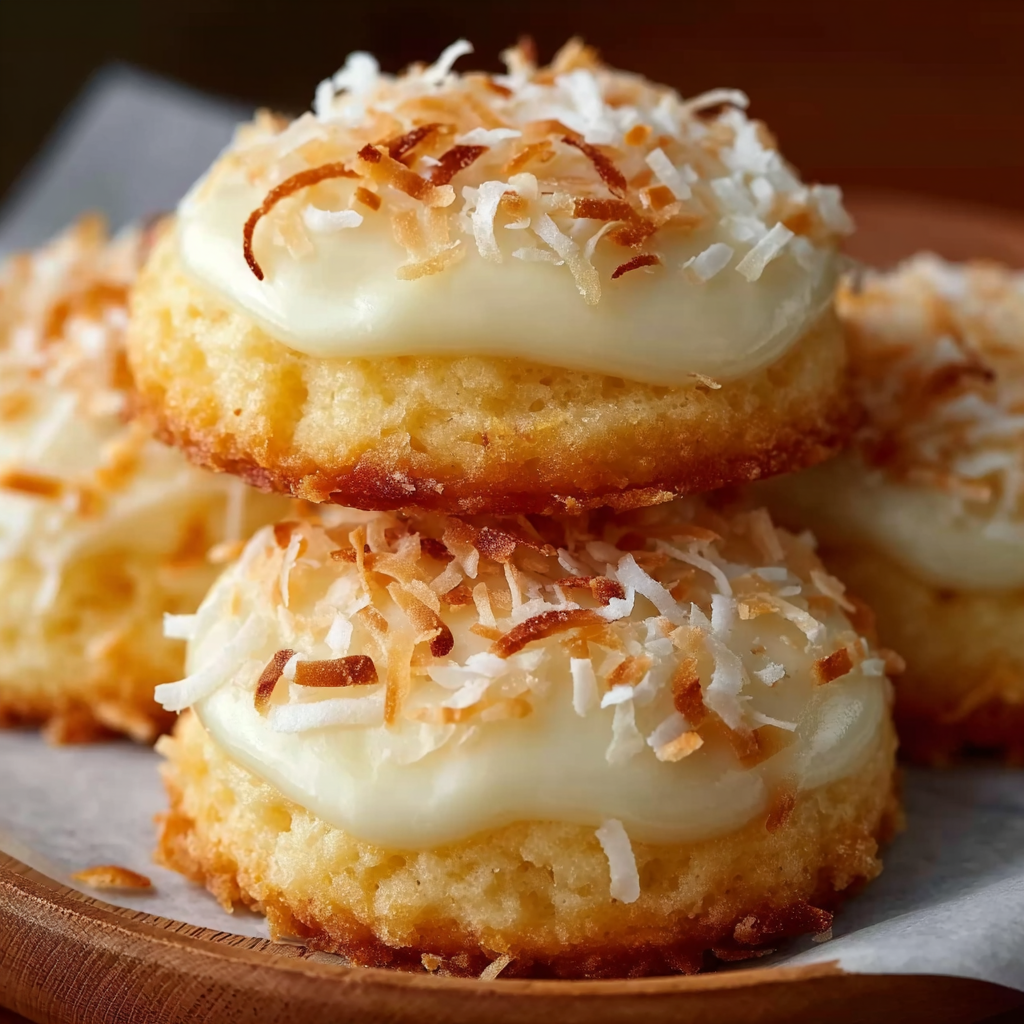
Smart Substitutions & Swaps
Customize these quick coconut biscuits without losing their buttery crumb. Keep fat, sugar, and flour in balance, and make changes one at a time. Always test a small batch first to check spread, sweetness, and texture before committing the full dough.
Swap to salted butter and reduce added salt slightly. If using self-raising flour, omit baking powder; the baking powder guide clarifies how chemical leavening stacks. For more specifics, see our substitutions chart, including tweaks for desiccated coconut versus sweetened shredded.
For dairy-free, use plant butter and canned condensed coconut milk; note sweetness shifts. Skipping milk powder reduces browning—see dry milk details. Gluten-free 1:1 blends benefit from xanthan and careful mixing; our GF baking guide and the flour overview outline structure tradeoffs.
When in doubt, chill the dough briefly to tame spread and sharpen edges.
Tools & Equipment
You only need basic tools to make these quick coconut biscuits with consistent results. Keep setup simple to speed prep and promote even baking across trays.
A mixing bowl, hand mixer, sheet pans, parchment, a 1-tablespoon scoop, and a scale cover essentials; see our kitchen gear list. For shaping ideas, browse coconut biscuit styles.
Optional: a fork for crosshatch, cookie stamps for patterns, and an oven thermometer. Verify temperature accuracy—biscuit basics and spread depend on steady heat.
Step-by-Step Instructions
Set yourself up for success by preparing pans and measuring ingredients before you start. These buttery milk biscuits mix fast, so organization prevents overmixing and promotes even color and crisp edges across the whole batch.
Cream unsalted butter and sugar until pale and fluffy; see butter composition for why temperature affects aeration. Blend in sweetened condensed milk and vanilla. Whisk flour, coconut, milk powder, salt, and baking powder—review the baking powder basics. Follow our visual photo tutorial to gauge ideal dough.
If crumbly, add milk by teaspoons until the dough just holds. Portion with a 1-tablespoon scoop, roll smooth, and lightly flatten. For shaping or finishing cues, browse coconut biscuit styles and see our cookie shaping tips.
-
Preheat oven to 350°F (175°C). Line two baking sheets with parchment.
-
Beat butter and sugar until light and fluffy, 2–3 minutes on medium speed.
-
Mix in condensed milk and vanilla until smooth and emulsified.
-
Whisk flour, milk powder, desiccated coconut, baking powder, and salt in a separate bowl.
-
Add dry to wet; mix just until a soft dough forms, scraping the bowl.
-
If dough seems dry, add milk 1 teaspoon at a time until it holds together.
-
Scoop 1-tablespoon portions, roll into balls, optionally coat in extra coconut, and gently flatten.
-
Bake 10–12 minutes until edges turn pale golden; cool 5 minutes, then rack.
Let biscuits cool fully for crisp edges; residual heat finishes setting the crumb gently.
Printable Recipe Card
Pro Tips & Baker’s Notes
Work with softened butter that feels cool; over-warm fat reduces aeration and increases spread. Mix only until the flour disappears. Pull biscuits when edges are pale golden—carryover heat completes baking.
If your oven runs hot or cool, verify with a thermometer; steady heat preserves crumb. See butter in baking for texture science, and review our oven calibration guide to avoid underbaked centers or over-browned bottoms.
Weigh coconut; packing yields excess. The desiccated coconut entry covers grind differences. For shaping consistency, reference our cookie sizing chart and scan coconut biscuit styles for spacing and finishing ideas.
Troubleshooting
Most issues trace to measurement, temperature, or mixing. Diagnose one variable at a time, and keep notes. Weigh ingredients, observe dough feel, and bake a single tester to confirm spread, browning, and crumb before scaling.
Dry, crumbly dough? Add milk by teaspoons until it just holds. Excess spread? Dough is warm or butter too soft—chill briefly. Pale color? The dry milk page shows why milk solids aid browning; peek at our doneness visual guide for color cues.
Dense, tough cookies suggest overmixing after flour; stir only to combine. Flat, greasy bottoms point to low flour or hot pans. For lift, ensure fresh baking powder—see the baking powder overview—and consult our ingredient troubleshooting hub.
Uneven browning often means crowded pans or inconsistent oven heat; rotate sheets halfway and verify temperature with an oven thermometer between batches carefully.
Make-Ahead, Storage & Freezing
This dough is flexible for planning ahead and gifting. Make it, chill it, or freeze portions to bake on demand. Proper wrapping prevents dryness and protects the buttery crumb so baked biscuits stay crisp yet tender.
Refrigerate dough up to 48 hours, wrapped airtight; let it warm slightly before scooping. For labeling and storage ideas, browse edible gift packaging and our make-ahead checklist.
Freeze scooped dough balls 2–3 months; bake from frozen, adding 1–2 minutes. Baked biscuits keep 4–5 days in airtight tins with paper towel. For long-term texture, see our freezer guide and reference shortbread storage parallels.
To re-crisp, warm biscuits at 300°F (150°C) for a few minutes, then cool completely on a wire rack.
Variations & Flavor Ideas
Use this base to spin easy coconut cookies for every season. Add bright citrus, chocolate accents, or a tender filling to transform texture and flavor while keeping the effortless method intact.
Try lime or lemon zest, cardamom, or cinnamon. Dip half the biscuit in dark chocolate or drizzle white. For styling, browse coconut biscuit styles and our decorating ideas for patterns that enhance crisp edges.
Go nutty with toasted almonds or macadamias, or add mini chips. Sandwich two biscuits with jam or dulce de leche. For gifting inspiration, see edible gift packaging and our cookie gift guide.
For extra coconut depth, lightly toast coconut first and cool completely before mixing into the dough for balance.
Dietary Swaps
Adapt these coconut biscuits for common needs while preserving texture. The key is managing moisture and structure when swapping dairy or gluten sources safely.
Dairy-free: plant butter plus condensed coconut milk; expect sweeter dough. Skipping milk powder reduces browning—see dry milk. Consult dairy-free baking primer for fat and salt adjustments.
Gluten-free: use a 1:1 blend with xanthan; mix gently. For structure expectations, flour overview helps. See our gluten-free cookie guide for hydration and rest time tips.
High-Altitude & Oven Notes
At altitude, adjust leavening and hydration mildly for these biscuits.
Add 1–2 tablespoons flour; reduce baking powder slightly—see basics.
Verify oven accuracy; consult our oven calibration checklist today.
Serving Ideas & Pairings
Serve with tea, coffee, or cold milk for coconut bliss.
Crumble over yogurt or ice cream; review shortbread texture.
Gift tins; browse edible packaging and gifting tips.
Nutrition & Allergens
Contains gluten and dairy; naturally egg-free as written for most.
Includes butter, milk powder, condensed milk; see condensed milk.
Calories vary by yield; use nutrition calculator for accuracy.
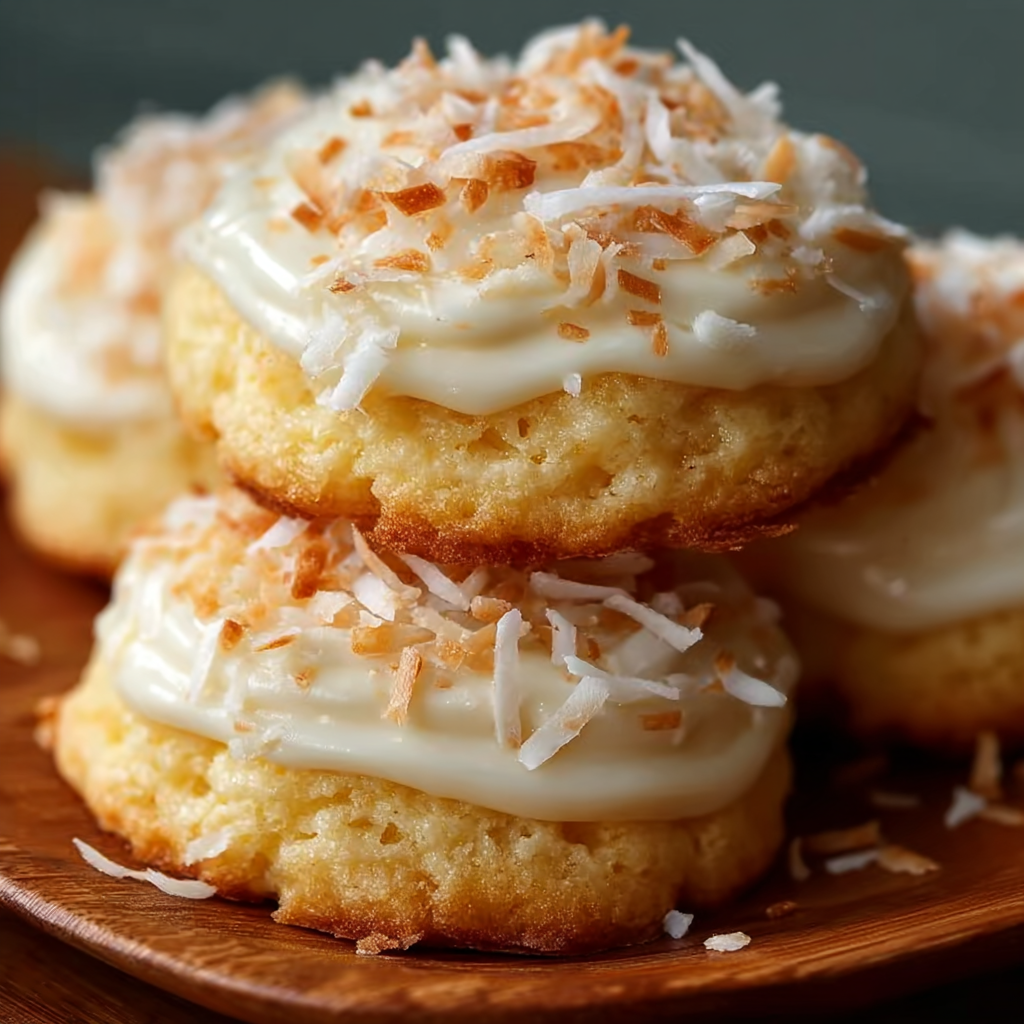
FAQs
Quick answers to the most common coconut biscuit questions so you can bake confidently and fix issues fast.
Difference from macaroons? Macaroons are egg-heavy and chewy; these are flour-and-butter cookies with a short crumb—see biscuit vs cookie. Fresh coconut instead of desiccated? Use well-drained, finely grated flesh; see desiccated coconut and our coconut prep tutorial.
Do I need milk powder? It boosts browning and dairy notes; skip if necessary, but expect paler cookies—learn more at dry milk. Using self-raising flour? Omit added leavener; review baking powder basics and our substitutions chart.
How do I keep them crisp, not chewy? Bake until edges are pale golden, cool fully on a rack, and store airtight with a paper towel. Why is my dough dry and crumbly? Coconut packs densely; add milk by teaspoons until the dough presses together. Can I freeze the dough or the baked biscuits? Yes; freeze scooped dough balls and baked cookies separately, then re-crisp briefly after thawing. How do I make them more coconutty? Toast coconut lightly and add a drop of coconut extract if desired. Are they gluten-free or dairy-free? Not as written; use a 1:1 gluten-free blend and plant butter with condensed coconut milk. How long do they keep? About 4–5 days at room temperature, longer frozen. Can I reduce the sugar? A small reduction is fine, but less sugar reduces spread and browning. Do I need to chill the dough? Not required, but a short chill can sharpen edges if your kitchen is warm. Bake one tester cookie first.
PrintCoconut Biscuits Recipes Guide To Easy Homemade Milk Biscuits
Quick Coconut Biscuits are buttery milk biscuits scented with vanilla and packed with unsweetened desiccated coconut for crisp edges and a short, tender crumb. The dough comes together in minutes—no chilling—thanks to creamed unsalted butter, granulated sugar, and a touch of sweetened condensed milk. Milk powder deepens dairy richness and encourages gentle browning, while baking powder provides light lift. Scoop, flatten, and bake for fragrant, golden cookies that pair perfectly with tea, coffee, or ice cream and make charming, packable gifts.
- Author: Clara
Ingredients
For the biscuits:
- ½ cup (115g) unsalted butter, softened
- ⅓ cup (65–70g) granulated sugar
- ⅓ cup (100g) sweetened condensed milk
- 2 tsp vanilla extract
- 1½ cups (190g) all-purpose flour
- ¼ cup (25–30g) milk powder
- 1 cup (85–90g) unsweetened desiccated coconut
- 1 tsp baking powder
- ¼ tsp fine salt
- 1–2 tbsp milk, as needed (if dough is dry)
For finishing (optional):
- Extra desiccated coconut for rolling
- Coarse sugar for sprinkling
Instructions
- Preheat oven to 350°F (175°C). Line two baking sheets with parchment.
- Beat butter and sugar until light and fluffy.
- Mix in condensed milk and vanilla until smooth.
- Whisk flour, milk powder, coconut, baking powder, and salt. Add to the butter mixture and stir just until a soft dough forms. If crumbly, add milk a teaspoon at a time until the dough holds together.
- Scoop 1-tablespoon portions, roll into balls, and, if you like, roll in extra coconut. Arrange on the sheets with space between; gently flatten with your fingers or a fork.
- Bake until edges are just turning golden, 10–12 minutes.
- Cool on the tray 5 minutes, then transfer to a rack to cool completely.
Notes
-
Soften butter to cool, pliable room temp; overly warm butter increases spread.
-
Weigh coconut; it compacts easily and can dry the dough if over-measured.
-
Add milk sparingly—just until the dough presses together without cracks.
-
Pull cookies when edges are pale golden; they continue to set as they cool.
-
For deeper coconut flavor, lightly toast a portion of the coconut before mixing.
-
A brief chill (10 minutes) helps in warm kitchens for sharper edges and neat crisscross patterns.
-
Store airtight with a paper towel to preserve crunch; re-crisp briefly in a low oven if needed.
